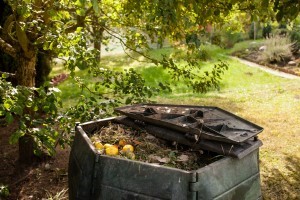How to Start a Compost Bin
by Donna Gilles 02/25/2018

If you keep a garden but find yourself throwing away leftover food, you're probably missing out on the opportunity to reclaim the nutrients of that food through composting. When you compost, you're essentially speeding up nature's process of breaking down organic matter into fertile soil. The compost can then be used to nourish the soil of your garden or lawn. Today you'll learn how to make a compost bin, mix the compost, and then spread it into your lawn and garden so you can make the most of the extra waste you have at home.
Making a compost bin
There are endless ways to make a compost bin. In fact, a bin isn't even necessary to make good compost, and some people choose to just keep a pile that they turn throughout the year. Making a bin has many advantages, however: it keeps the compost pile warm and moist (two essential elements that speed up decomposition), it keeps pests out of your compost, and it keeps your neighbors happy who might not want to smell decomposing food when they go outside.
Compost bins are commonly made from wood, chicken wire or plastic. Some towns even subsidize compost bins to encourage people to compost rather than throwing their compostable waste in the trash. Old wooden pallets are a great product to build compost bins from.
Adding compost to your bin
People who are new to composting often worry about what can be composted. Once you get started, though, you'll soon realize that almost any organic matter will break down in a compost bin. Beginners often stick to vegetables, coffee grounds, grains, and materials from your yard.
Greens and Browns
Compostable materials are often broken down into greens (nitrogen-based materials) and browns (carbon-based materials). Your compost bin doesn't need a perfect balance to be effective, but using some of each type of organic matter will produce the best results.
Too much brown matter in your bin will be hard to decompose. Too much green matter will make the compost slimy. Here are some examples of great carbon and nitrogenous materials to put in your bin:
Brown:
- dry leaves
- straw
- newspaper
- sawdust
- wood chips
Green:
- fruits and vegetables
- weeds from the yard
- fresh grass clippings
- flowers
- coffee grounds
Maintaining the compost pile
To create a good environment for decomposition you'll need three things: heat, moisture, and air. This makes compost bins relatively low-maintenance, but here are some tips to speed up the decomposition process:
Heat
In the spring and summer, nature will provide this for you, but having an enclosed bin that receives plenty of sunlight will help you out.
Moisture
The bacteria that are doing the composting in your bin require water to live. But too much water will make your bin a slimy mess. Shoot for moist, not wet.
Air
A compost bin needs to be aerated to blend the ingredients together. You don't need to turn it often; once every two to three weeks is fine.
Now that you know all you need to about making great compost for the lawn and garden, it's just a matter of mixing it in and reaping the rewards. Mix compost into garden soil and lawns early in the spring and in the fall after harvest to keep the soil healthy year-round.
 If you keep a garden but find yourself throwing away leftover food, you're probably missing out on the opportunity to reclaim the nutrients of that food through composting. When you compost, you're essentially speeding up nature's process of breaking down organic matter into fertile soil. The compost can then be used to nourish the soil of your garden or lawn. Today you'll learn how to make a compost bin, mix the compost, and then spread it into your lawn and garden so you can make the most of the extra waste you have at home.
If you keep a garden but find yourself throwing away leftover food, you're probably missing out on the opportunity to reclaim the nutrients of that food through composting. When you compost, you're essentially speeding up nature's process of breaking down organic matter into fertile soil. The compost can then be used to nourish the soil of your garden or lawn. Today you'll learn how to make a compost bin, mix the compost, and then spread it into your lawn and garden so you can make the most of the extra waste you have at home.
